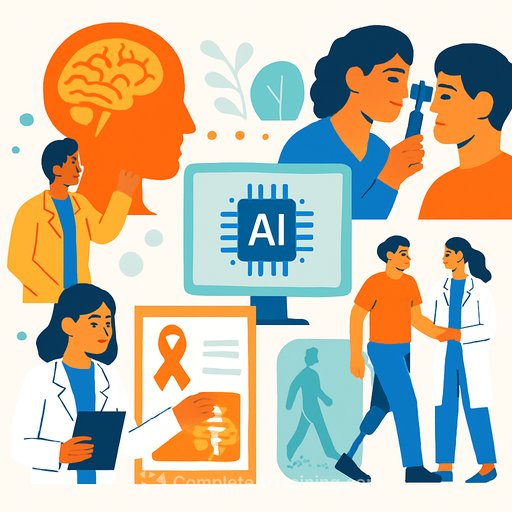Kerala pilots AI to speed stroke care, cervical cancer screening, and rehabilitation
Thiruvananthapuram: The Kerala Health Department is moving ahead with AI pilots in medical colleges and major government hospitals. The first wave targets acute stroke detection and streamlined treatment protocols.
AI will also be applied to Pap smear slide analysis for faster cervical cancer detection. With support from the Kerala Development and Innovation Strategic Council (K-DISC) on data validation, diabetic retinopathy screening is being added to the government's Nayanamrita eye care program.
Clinical pilots: what's coming to your unit
- Acute stroke detection and workflow: AI triage for CT/CTA can flag suspected LVO and ICH, shorten door-to-needle/door-to-groin times, and standardise activation protocols. Pair this with predefined escalation, telestroke consults, and audit of onset-to-imaging intervals. For reference standards and care goals, see the WHO stroke guidance.
- Cervical cancer screening: Whole-slide AI analysis can pre-classify Pap smears and surface atypical cells for cytopathologist review. Use it as a triage tool, measure sensitivity/specificity against your lab's gold standard, and monitor false negatives. WHO resources on elimination and screening strategies provide useful benchmarks: cervical cancer initiative.
- Diabetic retinopathy: Fundus cameras with AI pre-reads can be deployed in NCD clinics and integrated into Nayanamrita. Configure referral thresholds, ensure image quality checks, and track referral completion and vision outcomes.
Rehabilitation: AI-enabled gait training at Thiruvananthapuram General Hospital
An AI-driven G Gaiter from Gen Robotics is now helping patients walk again after stroke, spinal cord injuries, Parkinson's disease, and accidents. This is the first installation of its kind in a government hospital in India and has already supported hundreds of patients.
Clinically, focus on dose (steps per session), progressive challenge, safety (fall prevention), and outcome measures like 10MWT, 6MWT, and mRS. Use physiotherapist oversight and clear escalation rules for fatigue, pain, and autonomic changes.
Insurance outlook: coverage may lag
Several foreign insurers serving middle-income families are expected to enter Kerala with global capacity centres. They plan to use advanced AI to assess genetic and family health data for premium calculations.
AI-assisted treatments may not receive full reimbursement initially. Insurance advisor Viswanathan Odatt notes that 100% payment for AI-based therapies is unlikely without government guidelines and data-sharing frameworks. Expect partial coverage, pre-authorisation, and stricter documentation until policy catches up.
What healthcare leaders should do now
- Define clinical endpoints: For stroke, track door-to-imaging, door-to-needle, door-to-groin, discharge mRS, 90-day mRS. For screening, track sensitivity/specificity, PPV/NPV, recall rates, and time-to-report.
- Set human-in-the-loop boundaries: AI triage first; final clinical decisions remain with qualified clinicians. Document override reasons.
- Validate locally: Run silent trials on retrospective and prospective data. Compare performance across age, sex, comorbidities, and device vendors to detect bias.
- Standardise data: Ensure consistent imaging protocols, staining procedures, and metadata. Poor input quality will skew output and erode trust.
- Integrate with HIS/PACS/LIS: Push AI results back into existing workflows to avoid "app sprawl." Minimise extra clicks for clinicians.
- Create escalation playbooks: Define thresholds, call trees, and roles for neurologists, radiologists, cytopathologists, and rehab teams.
- Monitor safety: Log false negatives/positives, near misses, and adverse events. Review weekly during the pilot; monthly after scale-up.
- Consent and privacy: Align with ABDM identifiers and hospital data policies. Specify where data is processed (on-prem vs cloud), retention, and access controls.
- Procurement and contracts: Require clinical evidence, cybersecurity posture, uptime SLAs, auditability, versioning policies, and clear exit/portability terms.
- Reimbursement readiness: Map procedure and diagnosis codes, pre-authorisation steps, and documentation needed for AI-assisted care.
- Upskill your teams: Short training on capabilities, limits, common failure modes, and bias. Include radiology, pathology, neurology, ophthalmology, nursing, and IT.
- Report transparently: Publish pilot metrics to clinicians and administrators. Build confidence through data, not hype.
What this means for your patients
Faster stroke decisions can preserve brain tissue and reduce disability. Earlier detection of cervical lesions and diabetic retinopathy can shift care from late-stage treatment to prevention and timely intervention.
Rehab becomes more consistent and measurable, with clear goals and tracked progress. The challenge now is disciplined execution, strong governance, and continuous evaluation.
Next steps
Form a cross-functional AI-in-clinical-care committee, select one high-impact pathway per site, and run a time-bound pilot with predefined metrics. Share learnings across centres to accelerate safe scale-up.
If your team needs structured upskilling on practical AI workflows and evaluation, explore role-based options here: AI courses by job role.
Your membership also unlocks:






